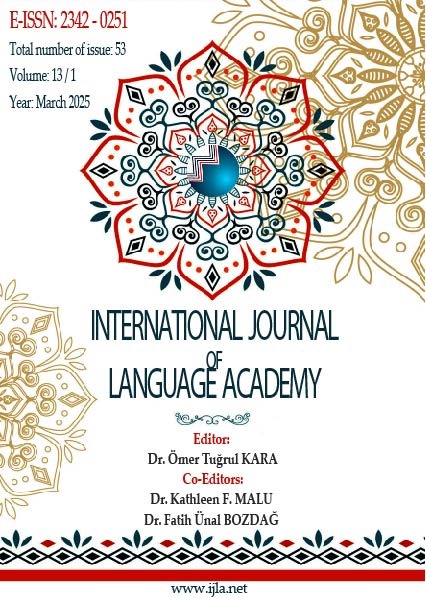ORTAOKUL DÜZEYİ TÜRKÇE DERS KİTAPLARINDAKİ HEDEF SÖZ VARLIĞI ETKİNLİKLERİNİN TÜRKÇENİN GENEL SÖZ VARLIĞI İLE SIKLIK TEMELLİ KARŞILAŞTIRILMASI
Author :
Abstract
Ana dili eğitiminde söz varlığı kazanımlarının aşamalandırılması için derlem temelli sıklık çalışmalarından yararlanma akademik bir öngörülebilirlik için gereklidir. Günümüzde ders kitaplarındaki söz varlığı çalışmalarının kitap yazarlarının seçimleriyle belirlendiği gözlenmektedir. Bu çalışmaların sıklık temelli yapılması ve sınıf düzeyine göre sözcüklerin derecelendirilmesi, söz varlığı kazanımlarına ölçülebilirlik niteliği kazandırması açısından önemlidir. Çalışmanın amacı ortaokul düzeyi Türkçe ders kitaplarında yer alan hedef söz varlığı etkinliklerini Türkçenin genel söz varlığı ile sıklık temelinde karşılaştırmaktır. Çalışmada Millî Eğitim Bakanlığı tarafından ortaokullarda kullanılan 5, 6, 7 ve 8. sınıf düzeyi Türkçe ders kitapları inceleme nesnesi olarak belirlenmiştir. Türkçe ders kitaplarında bulunan hedef söz varlığı etkinliklerinin içerdiği sözcükler görülme sıklıkları temel alınarak sınıf düzeylerine göre incelenmiştir. Sözcüklerin genel sıklık görünümlerine ulaşmak için Türkçe Ulusal Derleminin tanıtım sürümü (TUDv3) kullanılmıştır. Hedef sözcük sayıları, görülme sıklıkları, sıklığı en yüksek ve en düşük on sözcüğün tüm sözcüklerin sıklıklarına oranı ele alınmıştır. 5, 6, 7 ve 8. sınıf düzeyi hedef sözcük sayısı sırasıyla 136, 120, 116 ve 184’tür. Hedef sözcük listelerinin görülme sıklıkları ortalamaları incelendiğinde ise yine sırasıyla 119,32; 26,83; 61,38 ve son olarak 25,89 olduğu saptanmıştır. Sıklığı en yüksek ve en düşük sözcüklerin dağılımı ise yine heterojen bir görünüm sergilemektedir. Sözcük sayısı ve kullanım sıklığında görülen bu dalgalı dağılım, etkinliklere alınan sözcüklerin belirlenmesinin ve öğretilmesi hedeflenen sözcük sayısının kitap yazarlarının ana dili sezgilerine bırakıldığını göstermektedir. Söz varlığı çalışmaları, derlem temelli sözcük çalışmaları ile sınıf düzeyine uygun sıklık dağılımları belirlenerek planlanmalıdır.
Keywords
Abstract
Using corpus-based frequency studies for the grading of vocabulary learning in native language education is necessary for academic predictability. Today, vocabulary studies in textbooks are determined by the choices of book authors. Conducting these studies based on frequency and grading words according to grade level provides measurability to vocabulary learning outcomes. The aim of the study is to compare target vocabulary activities in middle school level Turkish textbooks with general vocabulary of Turkish based on frequency. In the study, 5th, 6th, 7th and 8th grade Turkish textbooks used as textbooks in middle schools by the Ministry of National Education were determined as the object of examination. The words included in the target vocabulary activities in Turkish textbooks were examined according to grade levels based on their frequency of occurrence. The basic version of the Turkish National Corpus (TUDv3) was used to reach the general frequency views of the words. The target word numbers, frequency of occurrence, and the ratio of the ten words with the highest and lowest frequency to the frequencies of all words were discussed. The number of target words at the 5th, 6th, 7th and 8th grade levels is 136, 120, 116 and 184, respectively. When the average frequency of target word lists is examined, it is found that they are again 119.32; 26.83; 61.38 and finally 25.89, respectively. The distribution of the highest and lowest frequency words again exhibits a heterogeneous appearance. This fluctuating distribution seen in the number of words and frequency of use shows that the determination of the words included in the activities and the number of words targeted to be taught are left to the native language intuitions of the book authors. Vocabulary studies should be planned by determining frequency distributions appropriate for the grade level with corpus-based vocabulary studies.





